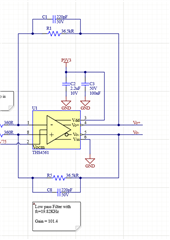Other Parts Discussed in Thread: INA849, INA163, , TINA-TI, THP210
This is a small board, part of a clients larger project. The output of the MIC is differential and has an impedance of 355 Ohms. They are going to be sampling at 250KHz, about 10x over sample. They don't really know how much gain they will need but expect the sound levels to be low. We decided to start with a gain of about 100. I chose the 10uF DC blocking cap because it I think it will form a high pass filter at about 44 Hz which is just below the bottom end frequency of the mic. I put the 220pf cap in the feedback to form a 20Khz low pass for antialiasing. I think the 715 ohm termination resistor will impendance match the mic to the amp. They have a differential DAC that has an midpoint (zero) at 0.75V so I have the Vocm set to that voltage.
For those of you who have lots of experience with fully differential amplifiers, have I made the correct assumptions? This is my fist time using one and I would like to get in the ballpark before making the board for the client.
Thank you for your help.


